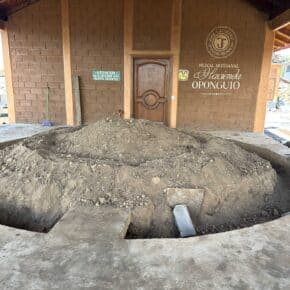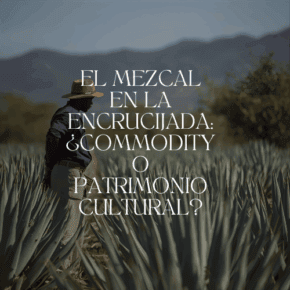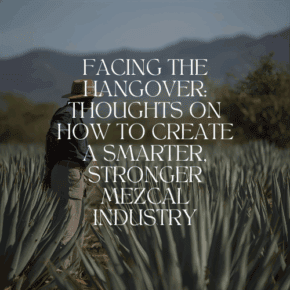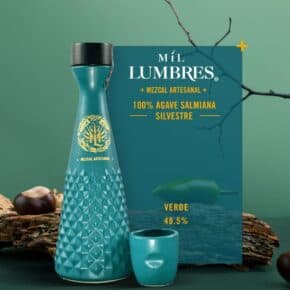
In early November I was fortunate enough to attend a Sagrantino de Montefalco tasting at Perbacco. Sagrantino is the grape, Montefalco the region within Umbria in Central Italy. This small appellation doesn’t get much exposure outside of the wine world. Not much is made, the price point reflects that, and the structure of these wines cries out for the cured meats, wild boar, and pastas particular to Umbria. That shouldn’t deter you from trying it because Sagrantinos are truly fantastic and unique. But this is a mezcal blog so what do they have to do with mezcal? The tasting got me thinking about that and the larger question of what European wine appellations can tell us as we think about how to define mezcal.

The tasting was organized by the consortium for Montefalco wines: The local wineries pay to belong as a marketing vehicle to produce events like this tasting and other promotions. But it’s also the member managed governing body for the appellation. The wine producers in Montefalco are continuously, if gradually, updating the definition of what it means to produce a Montefalco wine.
One of the key points of this tasting was a presentation on recent changes to the appellation. Wine makers spoke to the group about the changes to the definition of what it means to be a Montefalco. Here’s what’s changing: They’re very focused on being as organic and sustainable as possible so they’re using birds and insects to manage inset pests. They are now restricting the use of any inorganic substances to copper and sulphur. Why? Every speaker said that that Sagrantino sees itself as a natural wine, their farmers take great pride in tending their vines, and they want to distinguish themselves from everyone else by highlighting their attention to sustainability.
Apart from being an incredibly laudable statement on its own this is incredibly astute brand management. Look at it this way: The makers of Sagrantino decided that they want to tell the world loudly and proudly that they’re a sustainable product and they’re changing the rules to make sure that everyone creating Sagrantino wines has to use the same methods. That’s pretty disciplined and enlightened positioning on the international market where consumers are clamoring for all their food to be have some connection to sustainability. And that’s what really got me thinking about what we in the mezcal world can learn from Europe’s appellation system.
First, what is Montefalco Sagrantino? Wine has been produced in Montefalco since, at least 1088, probably much longer with some people dating it back to the Roman Empire. But it appears that different wines have been made from it over time. Monks produced a sweet wine from the Sagrantino grape in the Middle Ages. At some point, possibly always, people were making dry wines from Sagrantino but it seems like that may have been for local consumption, perhaps more home venting than anything else. But everything changed in 1979 when the Montefalco Sagrantino received a DOC, the legal title to the appellation in Italy. Later in 1992 it received an even more exclusive appellation title, DOCG. So, really, this wine was only recently defined. It’s perfectly possible that the beloved dry red wine of today only emerged just before or in response to the appellation.

Either way, over time a local consensus came to define the idea of how a Montefalco Sagrantino wine should be made and how it should taste. Once they got that far, the consortium wrote those ideas into law so that the identity of this wine would remain stable. If you produced a bottle, you had to comply with some basic rules about the grape varietals, aging, and production methods. If you purchased a bottle, you could make the same assumptions. Looming over these relatively objective facts that, for example, A Montefalco Rosso can contain 60-80% Sangiovese, 10-25% Sagrantino, and 0-30% other grapes, is the idea of taste. The assumption is that given the land, weather, and restrictions on what goes into a bottle, most Sagrantinos will share a common flavor profile. Regardless of whether that commonality is inherent to the grape or region it’s definitely true that local wine makers want to make wines that taste a certain way through some combination of adherence to tradition and desire to profit from a common market identity.
You could hear as much at this tasting as wine makers noted the objective characteristics of their wines, how much exposure to sunlight they receive, rainfall and drainage in that particular vintage. But of equal importance was how they described the more subjective identity of their bottles. They clearly understand that they’re operating within a continuum and that it’s in their interest to talk up the features that are common to all their wines. As you taste, the same idea emerges, some many be heartier or heavier, others much more refined, but they do have a similar set of flavors. Private conversations with wine makers at the tasting tell the same story: One says ‘his wines are obviously heavier and targeted at a different market’ another ‘ his are particularly subtle,’ but no one said ‘that’s not a Sagrantino.’
Back to what this has to do with mezcal: The whole idea of an appellation for agave spirits in Mexico is tremendously dynamic, the legal definition of mezcal is being revised right now while everyone else’s definition of mezcal is also in flux. The CRM is concluding a long process with a three tiered nomenclature for mezcal in NOM 70 while also creating an outlaw category of aguardiente de agave in NOM 199. But neither of those laws do much to describe what was actually happening in the mezcal industry. Instead of trying to define an appellation based on the style of mezcal in a particular village the CRM is lumping all mezcal together. Soon mezcal produced in Santa Caterina Minas will be defined the same as mezcal produced in San Baltazar Chichicapam even though they’re just a few miles apart and use entirely different production methods that result in bottles with completely different flavors.
Brands and mezcaleros haven’t been waiting patiently for the slow process of legislation to come to a conclusion. They have been busy carving out a new identity for all mezcals, especially their distinct bottles, in every way they can. Their labels are getting much better at prominently featuring the village where their mezcal is made, who made it, what agave was used, and whether any particular production methods were employed. The fact that you can depend on that information on many mezcal bottles today represents incredible progress for the industry, and organic progress led by brands and consumers who want to know this information.
But the recent profusion of brands trying to differentiate themselves by talking about their sustainability projects marks a keen comparison to appellations like Montefalco Sagrantino. Instead of the industry group getting together to define sustainability or levels of sustainability it’s let a thousand flowers bloom. It’s starting to feel like everyone has their own project to grow more agave, give back to local villages, or otherwise help the environment. It’s profoundly democratic and creative but also confusing for consumers simply because there are so many different claims flying around. The default response by Mr. or Mrs. Mezcal Lover may well be ‘they say it’s sustainable and that they’re giving back so that’s good, i’ll buy one of those bottles.’ That’s great but it doesn’t differentiate between who’s doing more and who might be using sustainability as a marketing ploy. Plus there’s no easy way for mezcal makers to share the knowledge of what’s most effective. There are tons of tiny silos of mezcal sustainability projects with zero or very little communication between them.
That’s obviously a problem that the Sagrantino consortium has been addressing, they foster all sorts of studies on sustainability, cultivation, vineyard management to ensure that their members can produce better wines. We’re missing that platform in the mezcal world but it’s perfectly possible that the absence of a European appellation system isn’t the problem. Step back and look at mezcal from a distance: It’s clear that the mezcal world has done brilliantly on its own so far. It’s growing at a brisk clip. Villages and individuals are working on all sorts of sustainability projects which have resulted in enormous changes to which agaves are cultivated today and how many are grown. Perhaps the organic development of the mezcal industry is a flower best left to grow at its own pace. Some people argue that adopting more of the European approach will only stunt the unique development of mezcal because the Mexican government has abused the appellation system so completely that it has no meaning for mezcal or tequila. The argument is that by lumping truly artisanal production together with big industrial producers the industrial guys are getting all the promotion they don’t need while artisanaly produced mezcal doesn’t get distinguished the way it should be. Put another way, the Mexican government is aggressively conflating Two Buck Chuck with a Montefalco Sagrantino so that only Two Buck Chuck wins from the arrangement.
As it is mezcaleros and brands have been diligently building their own identity and educating the world about why you should care about artisanal mezcal. Aficionados are gorging themselves on details and building up collections. Everyone else does what they always do. They ask their bar tender, liquor store owner, or read about it on the label, in a magazine article or whatever other word of mouth they depend on.
Why bring this up now? Like I said, we’re at an inflection point in category mezcal. Growth is strong but we’re rapidly reaching the point where consumer education is going to be the critical task. We have incredible traditions that are reflected in the spirits that come out maestro mezcaleros’ stills. How do we help the world understand just how unique and amazing those spirits are? We’ll be publishing different ideas about this so if you have thoughts we’d love to hear them.
Debate aside the Montefalco Sagrantino tasting was so nice because it was so different from your typical mezcal tasting. We were served a full meal at round tables where everyone chatted between presentations about the wine, the politics, the world at large. The producers were all involved, each standing up to talk about what made their bottle distinctive, but also talking about everything else on their minds. It’s something that we need to do much more with mezcal, taste while you dine and engage in that unregulated and unregulatable tradition of conversation. Now there’s a traditional idea.













Leave a Comment